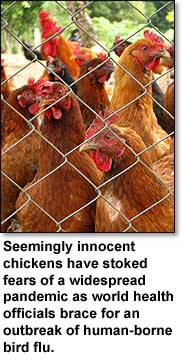Texas Tech University
Researcher Works To Prevent Bird Flu Mutations
Countries around the globe are hustling to prep themselves for a possible widespread outbreak of avian flu in humans. Dr. Julian Spallholz, a professor of Nutrition and Biochemistry at Texas Tech, is working to ensure that outbreak never occurs.
 The virus, H5N1, has grabbed the public spotlight in recent weeks.
Cases are cropping up in birds across Asia and Europe. Fears of a human
outbreak were stoked when scientists linked it to the devastating 1918
Spanish flu outbreak that killed as many as 50 million people. President
Bush recently proposed a massive $7.1 billion rapid-deployment pandemic
plan to prepare for an outbreak.
The virus, H5N1, has grabbed the public spotlight in recent weeks.
Cases are cropping up in birds across Asia and Europe. Fears of a human
outbreak were stoked when scientists linked it to the devastating 1918
Spanish flu outbreak that killed as many as 50 million people. President
Bush recently proposed a massive $7.1 billion rapid-deployment pandemic
plan to prepare for an outbreak.
The disease, currently confined mainly to poultry, could be kept from mutating into a form that can pass easily between humans by ensuring that all animal feed is fortified with enough selenium, Spallholz says.
Based upon the work of Melina Beck of the University of North Carolina at Chapel Hill and Orville Levander of the U.S. Department of Agriculture in Beltsville, Md., viral mutations have been demonstrated in selenium-deficient experimental animals. New human viruses are thought to emerge from selenium-deficient regions of the world such as Africa, China and Southeast Asia.
"A lot of these viral mutations that end up in the human population come from areas that probably have selenium-deficient soils,” says Spallholz, who has spoken on the topic recently in Thailand. “Asia is the natural melting pot for these viral evolutions that take place. Raising the levels of selenium in animal feed may help to reduce the frequency of these viral mutations."
Selenium is supplied to the diet chain of animals mostly through plant foods. The content of selenium in plant foods varies according to the content of selenium in the soil where the plants are grown and animals are raised.
However, selenium can be added, fairly easily and inexpensively, to animal feed as a supplement. Research suggests that the probability of viral mutations of bird flu may be reduced by making sure that producers provide enough selenium in the feed given to chickens, sheep, cattle and other livestock.
This will likely be necessary in rain-plagued Asia, where selenium is washed from the soil and, therefore, not available to plants and animals, Spallholz says.
Spallholz also believes selenium can also be used to improve upon existing anti-viral drugs such as Tamiflu to basically target and then deliver a toxic payload to the virus. Because of its extremely localized effect, selenium is otherwise harmless to surrounding cells.
-Cory Chandler

